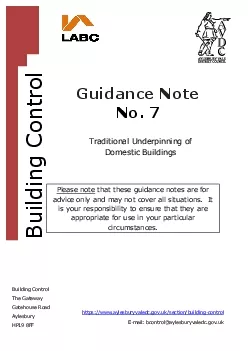

No 7Building ControlPlease notethat these guidance notes are for advice only and may not cover all situations It is your responsibility to ensure that they are appropriate for use in your particular ID: 887647
Download Pdf The PPT/PDF document "Guidance Note" is the property of its rightful owner. Permission is granted to download and print the materials on this web site for personal, non-commercial use only, and to display it on your personal computer provided you do not modify the materials and that you retain all copyright notices contained in the materials. By downloading content from our website, you accept the terms of this agreement.
1 Guidance Note No. 7 Building Contro
Guidance Note No. 7 Building Control Please note that these guidance notes are for advice only and may not cover all situations. It is your responsibility to ensure that they are appropriate for use in your particular circumstances. Traditional Underpinning of Domestic Buildings Building Control The Gateway Gatehouse R oad Aylesbury HP19 8FF https://www.aylesburyvaledc.gov.uk/section/building - control E - mail: bcontrol@aylesburyvaledc.gov.uk Traditional Underpinning of Domestic buildings not exceeding 2 storeys high 1. Feasibility Before underpinning is commenced, an investigation should be carried out by an experienced and competent person, to determine whether an underpinni ng procedure will achieve the object intended, i.e. to transfer the load carried on a foundation from its existing bearing level to a new level at a suitable lower depth. 2. Setting Out The wall to be underpinned should be marked into distinct one - metr e lengths and be numbered 1, 2, 3, 4 repeated in sequence . Setting out sequence for
2 underpinning excavations 3. Ex
underpinning excavations 3. Excavations Commencing with section marked 1, excavate under the existing footing/ foundation to a suitable depth - this wi ll vary upon ground conditions and proximity of trees, but will generally be at least one metre from finished ground level in clay soils. Sufficient working room will be required, and the rear face of the excavation should not be extend beyond the back of the existing concrete foundation unless the existing concrete foundation is of inadequate width, or should be centrally positioned under the brick footing, and be a minimum of 600mm wide. The underside of the footing/foundation should be cleaned, and 4no. 20mm diameter mild steel bars 600mm long should then be inserted 300mm into the sides of the excavation, one at each corner, to tie in adjacent sections. All work should be suitably supported during excavations. The excavation should then be checke d by the Building Control Surveyor. 4. Concreting The strength of concrete should be 25N/mm² (if self mixing, batch at 1:4 ordinary Portland cement
3 : all in ballast), and should be placed
: all in ballast), and should be placed the same day as completion of excavation. All concrete sho uld be poker vibrated, and should be placed to a level of 150mm minimum above the underside of the existing footing/foundation. Alternatively, place the concrete to a depth of 75mm below the existing footing/foundation and poker vibrate: after not less than 24 hours curing, dry pack the void with 1:3 cement:, sharp sand mixed with a minimal amount of water and well rammed into place. Allow a further 24 hours before excavating adjacent to a mass filled or dry packed underpinned section. Ex cavation of sections marked 2 may then take place. Follow the above procedure for section marked 3 and 4 to complete the work. 5. Backfilling All excavations for working width not concreted should be backfilled with clean stone, compacted in max 200mm thick layers. Source of Information: - BS 8004 : 1986 Foundations BRE Report: Foundation movement and remedial underpinning of low rise buildings: 1991. BRE Digest 352 - Underpinnin